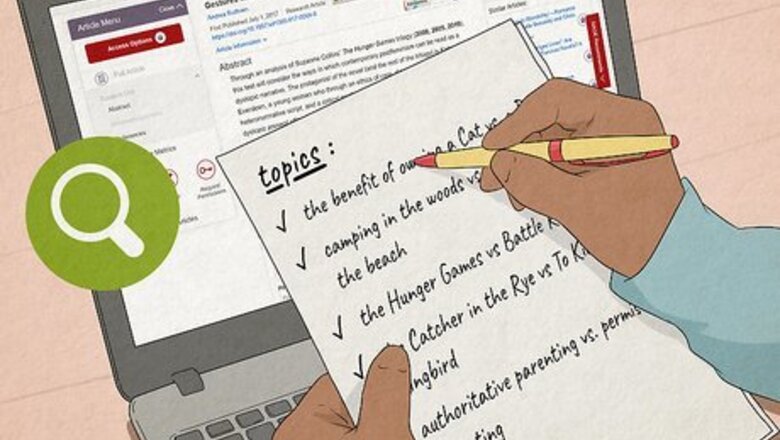
views
Pre-Writing
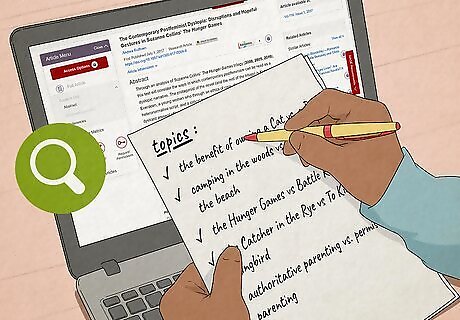
Choose a topic and research it. Typically, your teacher or instructor provides a list of topics to choose from for an essay. Read the assignment rubric, make sure you understand it, and pick a topic that interests you and that you think you can write a strong paper about. Then, start finding primary sources on your topic so you can back up the claims you'll make with evidence. If you have an idea for a topic that isn’t listed, feel free to ask your instructor if it would be okay to write about something that isn’t on the list they provided. In some cases, the teacher or professor might just provide an assignment sheet covering the logistics of the paper, but leave the topic choice up to you. If this happens, it can be helpful to come up with a short list of ideas on your own, then choose the best one. Don’t hesitate to ask your instructor for guidance on choosing a topic if you’re having trouble deciding.

Start by analyzing primary sources and looking for points to argue. This helps form your thesis statement, or a concise summary of the main point or claim of your paper, which all the other content will support. Read through your sources and try to find tension, ambiguity, interest, controversy, and complication in the information. Then, try to determine what the “why” is behind 1 or several points to develop your thesis statement. Note that there are different types of papers including research papers, opinion papers, and analytical essays. All of them need a thesis statement and all of them require you to do research and review various sources in order to write them. Your primary sources may come from the Internet, books, and various academic databases. Try to form your own ideas about your topic, based on your research. In other words, don’t just restate what the author of a source is already telling you. As you do your research, what questions do you find yourself asking? What patterns are you noticing? What are your own reactions and observations? Keep in mind that a thesis is not a topic, a fact, or an opinion. It is an argument based on observations and findings that you are trying to prove in your paper, like a hypothesis statement in a science experiment.

Write a brief thesis statement that tells readers what you’re arguing. Once you form an idea about your topic, write a clear, concise, and specific statement regarding the point you are going to argue to readers of your paper. Try to keep the statement to 1 or 2 sentences. Avoid using overly general terms and abstractions. An example of a thesis statement for a research paper is: “The Soviet Union collapsed because of the ruling class’s inability to tackle the economic problems of the common people.” This tells the reader what point you are going to back up with evidence in the rest of your paper. A thesis statement for an opinion paper might read something like: “Libraries are an essential community resource and as such should receive more funding from local municipal governments.” An analytical essay’s thesis statement could be: “JD Salinger makes heavy use of symbolism in The Catcher in the Rye in order to create feelings of melancholy and uncertainty in the novel.”
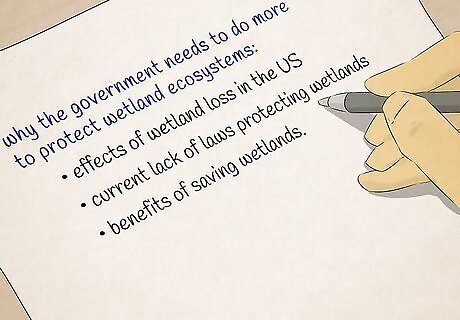
Make a list of major points to support your thesis as an outline. Write your thesis statement at the beginning of your outline. Write all the major points below it, leaving plenty of space between them for supporting points, and label them with Roman numerals. For example, if your thesis is about why the government needs to do more to protect wetland ecosystems, main supporting points could be: “effects of wetland loss in the US,” “current lack of laws protecting wetlands,” and “benefits of saving wetlands.” These major points form the body of your paper, in between your introduction and your conclusion.
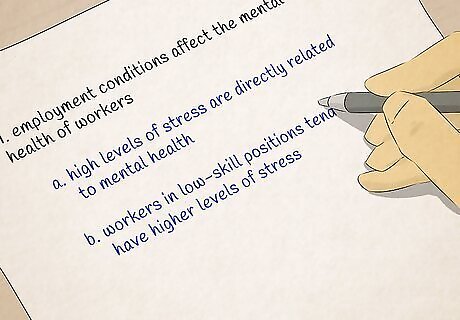
Write supporting ideas and arguments under each major point. Label these with capital letters. If you need to, break down these sub-points even more to help outline your ideas and label them with numbers and/or lowercase letters. For example, under a main point that says “employment conditions affect the mental health of workers,” your sub-points might be: “high levels of stress are directly related to mental health” and “workers in low-skill positions tend to have higher levels of stress.” Conduct additional research as needed to come up with supporting points to back up your thesis and major points.
Writing
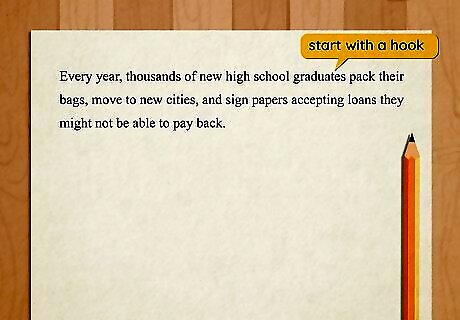
Start the introduction with something to hook the reader’s attention. This could be an interesting fact, a rhetorical question, a common misconception, or an anecdote about your topic. Whatever you choose to begin your essay with, make sure it’s something that encourages the reader to keep reading. For example, you could write something like: “Did you know that cattle ranching is the leading cause of deforestation in the Amazon rainforest?”

State the specific topic of your paper. After you hook the readers with the first sentence, write 1-2 sentences explaining what the topic of your paper is and why it’s important. Include any important background information to give readers context. For example, you might write something like: “It’s common for apps and social media to be demonized as a waste of time and brain space, but not all such technology should be considered mindless entertainment. In fact, many apps and social media networks can be used for educational and academic purposes.”

End the intro with your thesis statement. This is the standard placement for thesis statements and helps ensure the reader pays attention to it. Stick to this rule of thumb to keep your thesis statement prominent in the introduction to your paper. Make sure the background information about your topic that you include in your intro flows nicely into your thesis.

Discuss your major points in detail in the body of your paper. Refer back to your outline to remind yourself of your main points and their supporting sub-points. In general, aim to write 1 body paragraph for each main point. Introduce the point at the beginning of the paragraph, write a few sentences to back it up with evidence from your research, and summarize how it relates to your thesis statement in the last sentence. Think of each paragraph as kind of a mini essay in and of itself. Each paragraph should be a self-contained chunk of information that relates to the overall topic and thesis of your paper. Supporting evidence can be things like statistics, data, facts, and quotes from your sources
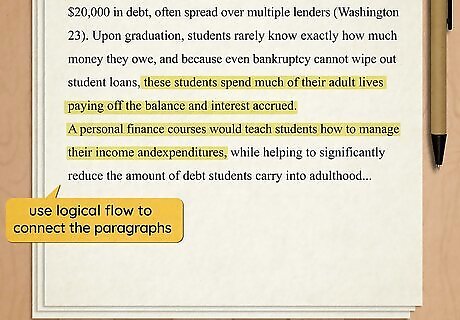
Connect your body paragraphs in a logical way. Organize the main points of your essay in the way that makes the most sense, so your paper flows well. For instance, if you’re arguing how 1 thing led to another in history, organize the paragraphs chronologically. Make sure each new paragraph clearly states the shift of focus to a new point. For example, put a paragraph about the reasons behind the collapse of the Soviet Union before a paragraph about the changes to Eastern European societies in the 90s, because the collapse of the Soviet Union directly led to many of those changes. If your first body paragraph discusses the extent of deforestation in the Amazon over the past decade, and your second paragraph is going to explain how that affects animal extinction, state the shift in focus by writing something like: “The deforestation of the Amazon over the last decade has resulted in a drastic reduction of natural habitats for many species.”

Start your conclusion by rephrasing your thesis statement. This reminds the reader what the point of your paper is. Make sure not to write the thesis statement differently from how you wrote it in your intro to restate your argument. For example, if your thesis in your intro was “The use of technology can benefit children because it improves developmental skills,” restate it something like this: “The use of technology contributes to children’s well-rounded development from a young age.”

Sum up your main supporting points and how they support your argument. Refer back to each major supporting point from the body of your paper and relate it back to your thesis statement. Try to tie all the pieces of your paper together in a few brief sentences. For example, you might write something like: “Deforestation is directly linked to climate change and increasingly extreme weather across the world, which is why global governments must take more action to stop illegal logging.”
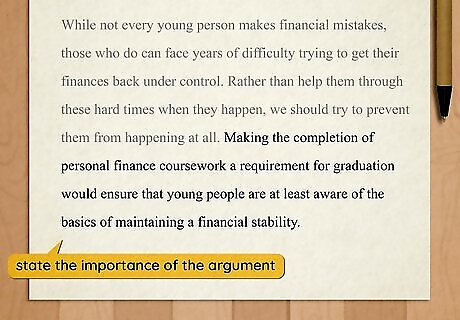
End by stating what the significance of your argument is. Tell your reader why they should care about your argument. State why it’s so important or what you want the reader to do, think, or feel when they walk away from reading your paper. For example, say something like: “Ignoring the realities of deforestation and climate change has grave implications for all of us. If we don’t start putting more pressure on governments to act, your children or grandchildren will be living in a very different world from that which we inhabit today.”
Citing Sources
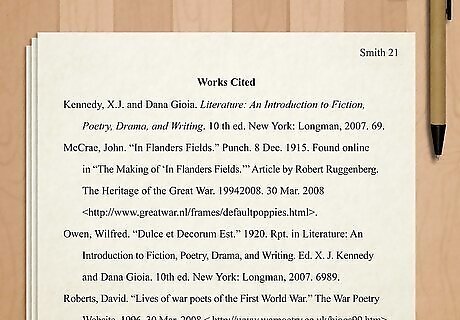
Write an MLA-style works cited page for humanities papers. Label the last page of your paper “Works Cited” and center the heading. List the titles of your sources aligned with the left margin, double-spacing them and indenting any lines beyond the first for each source. Include page numbers for print sources where applicable and list URLs for online sources. Humanities subjects include language arts and cultural studies. Note that these are just the basic rules for writing an MLA-style works cited page. For a full list of rules regarding all things MLA and citations, refer to an MLA handbook. Note that there is some crossover between certain subjects, in which case more than 1 style of works cited or reference page may be acceptable. Always review your assignment rubric or ask your professor which style of citations they prefer before writing your reference or works cited page.
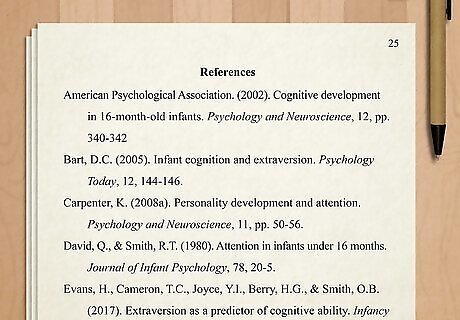
Cite references in APA style for social sciences papers. Center the headlines “References” at the top of a page at the end of your paper. Left-align the titles of your sources and indent and double-space all lines. Social sciences include psychology, sociology, and anthropology. Refer to an APA style guide for complete rules about how to list different types of sources.
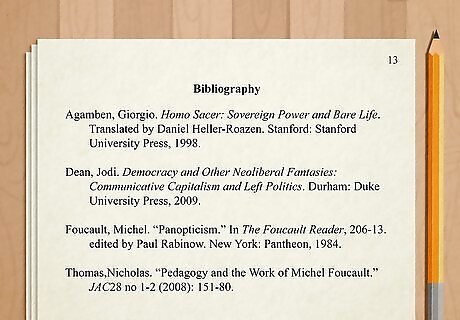
Cite sources in Chicago style for business, history, and fine arts papers. Place numbered footnotes after pieces of text you want to cite in your paper. Place citations at the bottom of the page for each footnote on that page. Alternatively, put the author’s name and the date of publication in parentheses after the text you want to cite. Check a Chicago Manual of Style for more specific instructions about citations. Note that Chicago style is more commonly used for published works. If you’re a student, your professor might instruct you to use MLA format for your papers.
Revising, Editing, and Proofreading

Analyze your paper and eliminate unnecessary information. Take a break from writing after you finish your first draft, then go back and read your paper from beginning to end. Try to imagine that your paper was written by someone else and analyze how readers may interpret your paper. Consider your thesis and make sure all the evidence backing it up in your paper is relevant — remove anything that is not totally necessary for supporting your thesis, or rewrite it to explain it better and make it more obviously relevant. Anywhere from a few hours to a day is a good amount of time to wait before you start revising your paper. The point is to come back to it with a fresh set of eyes. If you can, get a roommate, a family member, a friend, or a classmate to read your paper too. Ask them for advice on ways you could make your argument and your evidence more clear or relevant. Here are 3 questions to ask yourself as you read each sentence and piece of information in your paper: Is this really worth saying? Does this say what I want it to say? Will readers understand what I’m saying?
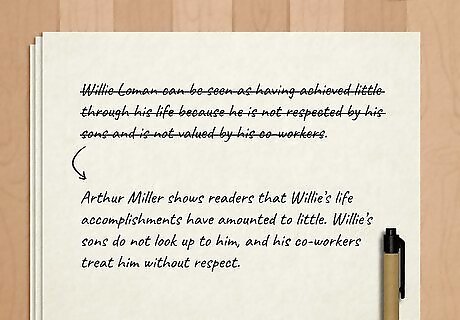
Tighten and clean up the language. Look for confusing sentences or ideas and revise them to make them more clear. Get rid of extra words that aren’t necessary to convey your point, as well as vague words or misused words. It helps to read your paper out loud as you do this. Listen for awkward pauses, phrases, and sentence structure, and revise them so the writing flows better. Try copying and pasting your essay into the free online tool called “Hemingway.” The app suggests many different ways to make your writing clearer, more direct, and more readable.

Edit for repetition and look for better words to use. Look for ways to make your paper even more polished by eliminating repetition of the same word in sentences or paragraphs. Look for more descriptive or more precise words to use to add variety. A thesaurus really helps here! Take this sentence as an example: “The collapse of the Soviet Union resulted in the collapse of local governments and economies across Eastern Europe.” Instead of using “collapse” twice, replace the second instance with “crumbling.”
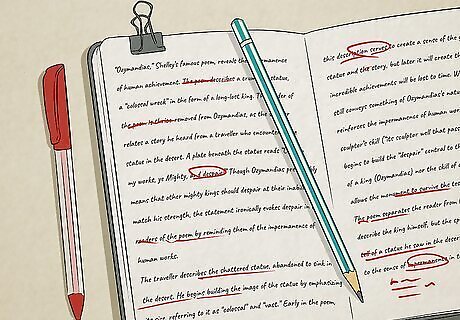
Proofread for spelling, grammar, and punctuation errors. This is the final step before turning your paper in! Run spell check on your word processor to catch obvious mistakes. Then, read through your essay a final time and look for anything the computer didn’t catch. It’s also a good idea to paste your paper into a third-party tool, like Grammarly, for a final spelling and grammar check. Not every program catches everything, so it’s better to be on the safe side!


















Comments
0 comment